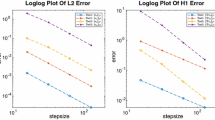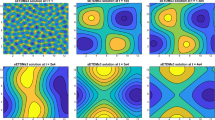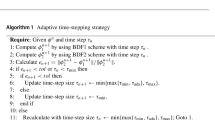Abstract
We develop in this paper highly efficient, second order and unconditionally energy stable schemes for the epitaxial thin film growth models by using the scalar auxiliary variable (SAV) approach. A main difficulty here is that the nonlinear potential for the model without slope selection is not bounded from below so the SAV approach can not be directly applied. We overcome this difficulty with a suitable splitting of the total free energy density into two parts such that the integral of the part involving the nonlinear potential becomes bounded from below so that the SAV approach can be applied. We then construct a set of linear, second-order and unconditionally energy stable schemes for the reformulated systems. These schemes lead to decoupled linear equations with constant coefficients at each time step so that they can be implemented easily and very efficiently. We present ample numerical results to demonstrate the stability and accuracy of our SAV schemes.











Similar content being viewed by others
References
Caflisch, R.E., Gyure, M.F., Merriman, B., Osher, S.J., Ratsch, C., Vvedensky, D.D., Zinck, J.J.: Island dynamics and the level set method for epitaxial growth. Appl. Math. Lett. 12(4), 13–22 (1999)
Chen, W., Conde, S., Wang, C., Wang, X., Wise, S.: A linear energy stable scheme for a thin film model without slope selection. J. Sci. Comput. 52, 546–562 (2012)
Chen, Wenbin, Wang, Cheng, Wang, Xiaoming, Wise, Steven M.: A linear iteration algorithm for a second-order energy stable scheme for a thin film model without slope selection. J. Sci. Comput. 59(3), 574–601 (2014)
Clarke, S., Vvedensky, D.D.: Origin of reflection high-energy electron-diffraction intensity oscillations during molecular-beam epitaxy: a computational modeling approach. Phys. Rev. Lett. 58(21), 2235 (1987)
Elliott, C.M., Stuart, A.M.: The global dynamics of discrete semilinear parabolic equations. SIAM J. Numer. Anal. 30, 1622–1663 (1993)
Eyre, D.J.: Unconditionally gradient stable time marching the Cahn–Hilliard equation. In: Computational and Mathematical Models of Microstructural Evolution, San Francisco, CA, 1998, Volume 529 of Materials Research Society Symposia Proceedings, pp. 39–46. MRS, Warrendale, PA (1998)
Gyure, M.F., Ratsch, C., Merriman, B., Caflisch, R.E., Osher, S.T., Zinck, J.J., Vvedensky, D.D.: Level-set methods for the simulation of epitaxial phenomena. Phys. Rev. E 58(6), R6927 (1998)
Kang, H.C., Weinberg, W.H.: Dynamic Monte Carlo with a proper energy barrier: surface diffusion and two-dimensional domain ordering. J. Chem. Phys. 90(5), 2824–2830 (1989)
Krug, J.: Origins of scale invariance in growth processes. Adv. Phys. 46(2), 139–282 (1997)
Li, B., Liu, J.G.: Epitaxial growth without slope selection: energetics, coarsening, and dynamic scaling. J. Nonlinear Sci. 14(5), 429–451 (2004)
Moldovan, D., Golubovic, L.: Interfacial coarsening dynamics in epitaxial growth with slope selection. Phys. Rev. E 61(6), 6190 (2000)
Qiao, Z., Zhang, Z., Tang, T.: An adaptive time-stepping strategy for the molecular beam epitaxy models. SIAM J. Sci. Comput. 33(3), 1395–1414 (2011)
Qiao, Z., Sun, Z.-Z., Zhang, Z.: Stability and convergence of second-order schemes for the nonlinear epitaxial growth model without slope selection. Math. Comput. 84(292), 653–674 (2015)
Shen, J., Wang, C., Wang, X., Wise, S.M.: Second-order convex splitting schemes for gradient flows with Ehrlich–Schwoebel type energy: application to thin film epitaxy. SIAM J. Numer. Anal. 50(1), 105–125 (2012)
Shen, J., Yang, X.: Numerical approximations of Allen–Cahn and Cahn–Hilliard equations. Discrete Contin. Dyn. Syst. A 28, 1669–1691 (2010)
Shen, J., Xu, J., Yang, J.: A new class of efficient and robust energy stable schemes for gradient flows. Submitted to SIAM Rev.
Shen, J., Jie, X., Yang, J.: The scalar auxiliary variable (SAV) approach for gradient flows. J. Comput. Phys. 352, 407–417 (2018)
Villain, J.: Continuum models of crystal growth from atomic beams with and without desorption. Journal de physique I 1(1), 19–42 (1991)
Wang, C., Wang, X., Wise, S.M.: Unconditionally stable schemes for equations of thin film epitaxy. Discrete Contin. Dyn. Syst. 28(1), 405–423 (2010)
Xu, C., Tang, T.: Stability analysis of large time-stepping methods for epitaxial growth models. SIAM J. Numer. Anal. 44(4), 1759–1779 (2006)
Yang, X.: Linear, first and second order and unconditionally energy stable numerical schemes for the phase field model of homopolymer blends. J. Comput. Phys. 327, 294–316 (2016)
Yang, X., Zhao, J., Wang, Q.: Numerical approximations for the molecular beam epitaxial growth model based on the invariant energy quadratization method. J. Comput. Phys. 333, 104–127 (2017)
Yue, P., Feng, J.J., Liu, C., Shen, J.: A diffuse-interface method for simulating two-phase flows of complex fluids. J. Fluid Mech. 515, 293–317 (2004)
Acknowledgements
This work is supported in part by NSFC Grants 91630204, 11421110001 and 51661135011, and NSF Grants DMS-1720442 and DMS-1720212.
Funding
Funding was provided by Directorate for Mathematical and Physical Sciences (Grant No. DMS-1620262).
Author information
Authors and Affiliations
Corresponding author
Rights and permissions
About this article
Cite this article
Cheng, Q., Shen, J. & Yang, X. Highly Efficient and Accurate Numerical Schemes for the Epitaxial Thin Film Growth Models by Using the SAV Approach. J Sci Comput 78, 1467–1487 (2019). https://doi.org/10.1007/s10915-018-0832-5
Received:
Revised:
Accepted:
Published:
Issue Date:
DOI: https://doi.org/10.1007/s10915-018-0832-5




